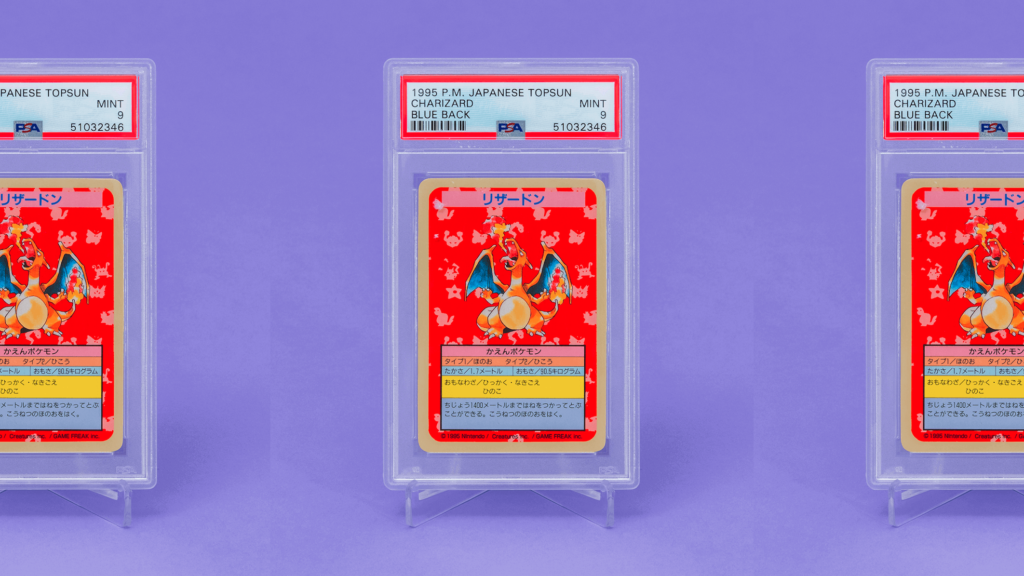The Pokémon universe is complex and expansive, boasting a multi-billion dollar market and massive global appeal. Pokémon cards have always been central to that broad universe and with the card and collectible market being as hot as it is on top of a resurgent interest in the franchise…Pokémon cards are certainly getting their day in the sun with the 1995 Pokémon Topsun Blue Back No Number PSA 9 being a particularly excellent example. For quick perspective on the current demand level for these types of cards just look to January 2021 when the 1/1 PSA 10 1995 blue-back no-number Topsun Charizard sold for $493,230, setting a new record as the highest selling Pokémon card of all time.
As with any cultural giant, and with any asset for that matter, there are myriad ways to break down value, influence, and impact.
Featured Character
Because Pokémon’s genesis was a game where players could build their characters’ stories, collectors and players have been intimately tied to their favorite Pokémon since day 1. As such, when looking at a card’s value, the featured character on the card really matters – it’s often fundamentally what drives demand. Knowing which characters are favorites and flagships within the broader space is essential to understanding demand and collecting behavior.
For example, knowing that Charizard is undoubtedly the most in-demand Pokémon amidst the current card craze is a key factor when assessing value of a card. If a card features one of these fan-favorite characters, like Charizard, it’s usually a good place to start.
Population
Foundationals and first editions within any kind of population tend to be valued above all else. As with any editioned, syndicated, printed, versioned anything (from art to cards to bags)… firsts are important because they lay the groundwork for a series, a character, an athlete’s career, a superhero’s arc, etc.
These objects represent moments where entire worlds originate. As such, understanding which population (1st edition, base set, etc.) any Pokémon card comes from is key to understanding its value.
As an example, according to PokeBoon, the Topsun blue back Pokémon cards were originally released between 1995-1997 by Top-Seika and randomly inserted into packs of apple-flavored gum predating the TCG cards by years meaning they represent a special subset of the overall Pokémon card population.
Topsun blue backs are the cards born before the larger first edition population – they’re the origin cards. Population size matters because it helps to place an individual card within a greater context.
In the case of a 1995 Topsun blue back, no-number Charizard…there are only 11 Charizards graded as PSA 9 and only 1 graded as PSA 10 – versus the 666 1999 1st Edition Holo Charizards graded as PSA 9 and 122 graded as PSA 10.
To go a level deeper, not even all Topsun cards, let alone Topsun blue backs can be judged by the same measuring stick. Topsun green back cards were in a second, later set and are less rare due to their run size, making the blue back more coveted.
Condition
As is the case with any physical asset – condition matters. Age compounds the value of good condition in that, simply put, older stuff that’s better preserved means more to collectors. This really comes into play for cards and any collectible that was produced with the intention of being physically handled, especially Pokémon cards, which were created for gameplay.
Topsun cards, specifically, were novel by design – literally meant to be played with – and put into packs of gum. Their runs were smaller and their production was less controlled because collecting wasn’t the goal – the goal was more utilitarian in nature, to handle them while playing a game.
If something survives being in packs of gum, potentially being used during gameplay, and traveling around in pockets or boxes over the course of 20+ years…and comes out the other side in excellent condition (highly graded) – it’s special.
Scarcity
Scarcity is a combination of all the above factors. In the case of a Pokémon card…Does it feature a special or favorite character? Was it part of a small and unique group to begin with? Is it part of an origin story? Has it held up physically? The more “yeses” to these questions, the rarer and rarer that thing becomes and the greater the demand amongst collectors.
Expand your investment portfolio beyond cards
For many, collecting and trading cards is more than just a hobby. And when you’re ready to explore opportunities beyond the world of cards, Public is here to help. On Public, you can build a multi-asset portfolio of stocks, options, bonds, crypto, ETFs and more. Plus, you can access AI-powered fundamental data and custom analysis to guide your investment decisions.
Sign up today and explore how you can expand your investment portfolio beyond card collecting. With options like high-yield cash accounts (HYCA) and expert guidance on stocks, crypto, and ETFs, Public is your platform for smarter investing.


